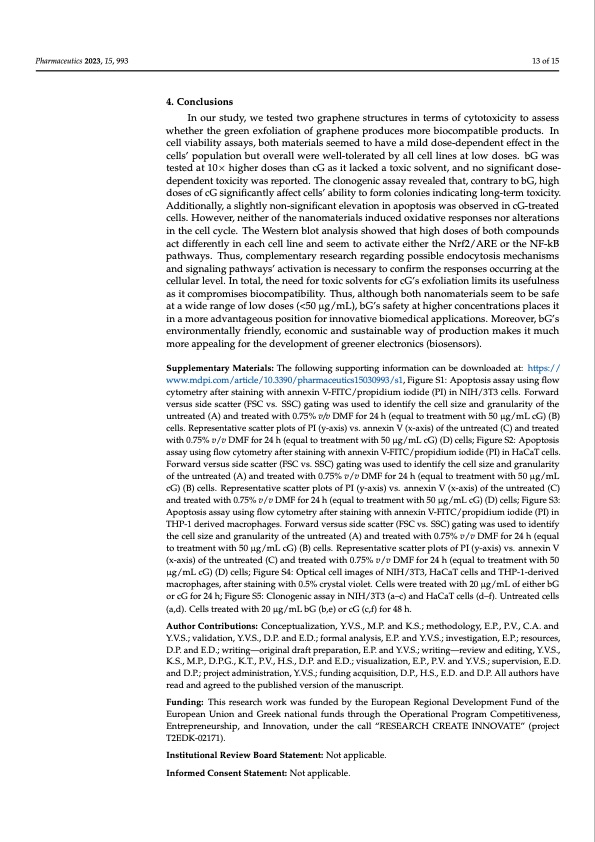
PDF Publication Title:
Text from PDF Page: 013
Pharmaceutics 2023, 15, 993 13 of 15 4. Conclusions In our study, we tested two graphene structures in terms of cytotoxicity to assess whether the green exfoliation of graphene produces more biocompatible products. In cell viability assays, both materials seemed to have a mild dose-dependent effect in the cells’ population but overall were well-tolerated by all cell lines at low doses. bG was tested at 10× higher doses than cG as it lacked a toxic solvent, and no significant dose- dependent toxicity was reported. The clonogenic assay revealed that, contrary to bG, high doses of cG significantly affect cells’ ability to form colonies indicating long-term toxicity. Additionally, a slightly non-significant elevation in apoptosis was observed in cG-treated cells. However, neither of the nanomaterials induced oxidative responses nor alterations in the cell cycle. The Western blot analysis showed that high doses of both compounds act differently in each cell line and seem to activate either the Nrf2/ARE or the NF-kB pathways. Thus, complementary research regarding possible endocytosis mechanisms and signaling pathways’ activation is necessary to confirm the responses occurring at the cellular level. In total, the need for toxic solvents for cG’s exfoliation limits its usefulness as it compromises biocompatibility. Thus, although both nanomaterials seem to be safe at a wide range of low doses (<50 μg/mL), bG’s safety at higher concentrations places it in a more advantageous position for innovative biomedical applications. Moreover, bG’s environmentally friendly, economic and sustainable way of production makes it much more appealing for the development of greener electronics (biosensors). Supplementary Materials: The following supporting information can be downloaded at: https:// www.mdpi.com/article/10.3390/pharmaceutics15030993/s1, Figure S1: Apoptosis assay using flow cytometry after staining with annexin V-FITC/propidium iodide (PI) in NIH/3T3 cells. Forward versus side scatter (FSC vs. SSC) gating was used to identify the cell size and granularity of the untreated (A) and treated with 0.75% v/v DMF for 24 h (equal to treatment with 50 μg/mL cG) (B) cells. Representative scatter plots of PI (y-axis) vs. annexin V (x-axis) of the untreated (C) and treated with 0.75% v/v DMF for 24 h (equal to treatment with 50 μg/mL cG) (D) cells; Figure S2: Apoptosis assay using flow cytometry after staining with annexin V-FITC/propidium iodide (PI) in HaCaT cells. Forward versus side scatter (FSC vs. SSC) gating was used to identify the cell size and granularity of the untreated (A) and treated with 0.75% v/v DMF for 24 h (equal to treatment with 50 μg/mL cG) (B) cells. Representative scatter plots of PI (y-axis) vs. annexin V (x-axis) of the untreated (C) and treated with 0.75% v/v DMF for 24 h (equal to treatment with 50 μg/mL cG) (D) cells; Figure S3: Apoptosis assay using flow cytometry after staining with annexin V-FITC/propidium iodide (PI) in THP-1 derived macrophages. Forward versus side scatter (FSC vs. SSC) gating was used to identify the cell size and granularity of the untreated (A) and treated with 0.75% v/v DMF for 24 h (equal to treatment with 50 μg/mL cG) (B) cells. Representative scatter plots of PI (y-axis) vs. annexin V (x-axis) of the untreated (C) and treated with 0.75% v/v DMF for 24 h (equal to treatment with 50 μg/mL cG) (D) cells; Figure S4: Optical cell images of NIH/3T3, HaCaT cells and THP-1-derived macrophages, after staining with 0.5% crystal violet. Cells were treated with 20 μg/mL of either bG or cG for 24 h; Figure S5: Clonogenic assay in NIH/3T3 (a–c) and HaCaT cells (d–f). Untreated cells (a,d). Cells treated with 20 μg/mL bG (b,e) or cG (c,f) for 48 h. Author Contributions: Conceptualization, Y.V.S., M.P. and K.S.; methodology, E.P., P.V., C.A. and Y.V.S.; validation, Y.V.S., D.P. and E.D.; formal analysis, E.P. and Y.V.S.; investigation, E.P.; resources, D.P. and E.D.; writing—original draft preparation, E.P. and Y.V.S.; writing—review and editing, Y.V.S., K.S., M.P., D.P.G., K.T., P.V., H.S., D.P. and E.D.; visualization, E.P., P.V. and Y.V.S.; supervision, E.D. and D.P.; project administration, Y.V.S.; funding acquisition, D.P., H.S., E.D. and D.P. All authors have read and agreed to the published version of the manuscript. Funding: This research work was funded by the European Regional Development Fund of the European Union and Greek national funds through the Operational Program Competitiveness, Entrepreneurship, and Innovation, under the call “RESEARCH CREATE INNOVATE” (project T2EDK-02171). Institutional Review Board Statement: Not applicable. Informed Consent Statement: Not applicable.PDF Image | Green Exfoliation of Graphene

PDF Search Title:
Green Exfoliation of GrapheneOriginal File Name Searched:
pharmaceutics-15-00993.pdfDIY PDF Search: Google It | Yahoo | Bing
Salgenx Redox Flow Battery Technology: Power up your energy storage game with Salgenx Salt Water Battery. With its advanced technology, the flow battery provides reliable, scalable, and sustainable energy storage for utility-scale projects. Upgrade to a Salgenx flow battery today and take control of your energy future.
| CONTACT TEL: 608-238-6001 Email: greg@infinityturbine.com | RSS | AMP |